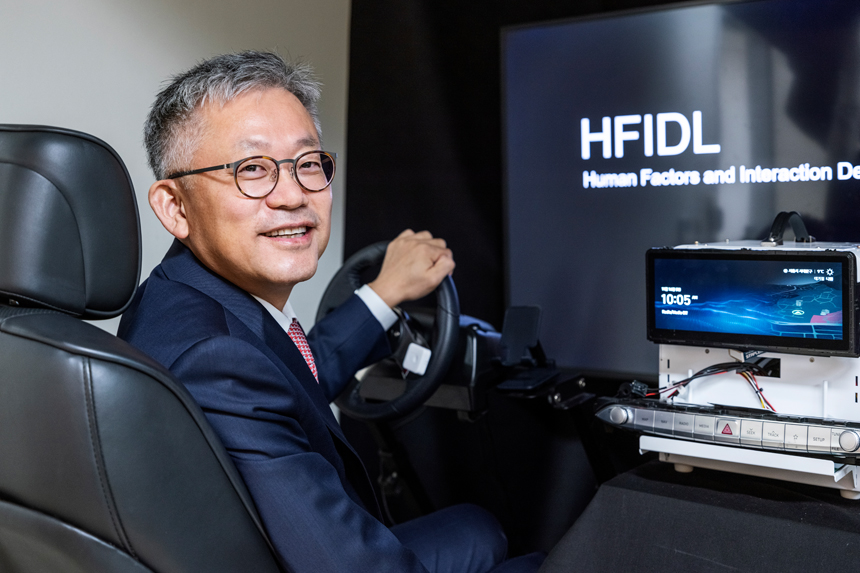- Engineering for Humans with Sensibility November 30, 2021
-
by Professor Yong Gu Ji, Department of Industrial Engineering

What is "Interaction Design?"
Humans are interacting with various objects all day long, from opening their eyes to falling asleep. And this is precisely where interaction design plays its role. Interaction design is an area of research that takes an interest in and studies the design of artifacts to ensure interactions with their users can be more effective and efficient. When it comes to the scope of interactive design studies, it covers a vast range of artifacts, from furniture such as toilets, beds, sofas, and chairs, to smartphones, intelligent cars, AI devices, and even machines or robots in smart factories. Since every tangible object can be a subject of research, those in the field of interaction design would sometimes make humorous remarks that everything regarding their research is purchasable as long as it is within the research budget allocated; in other words, there is virtually no limit when it comes to research subjects in the field of interaction design.
With various factors at work when it comes to interaction between humans and artifacts, many academic fields are involved in interaction design: ranging from conventional areas of study such as psychology, sociology, and anthropology to fields such as computer science, ergonomics, HCI (human-computer interaction), industrial design as well as convergence academic fields. Researchers from various areas attempt to find solutions to different problems related to interaction design using their respective theories and techniques.
The Human Factors & Interaction Design Laboratory (HFIDL), which belongs to the Department of Industrial Engineering of Yonsei University, mainly analyzes the interaction efficiency and effectiveness of humans and artifacts through qualitative and quantitative approaches, using theories and techniques of ergonomics and HCI. Ultimately, its objective is to present ways to improve the quantitative aspects of interaction. Many research projects are being actively conducted through cooperation with various industries, such as the development of haptic seats for automobiles, smartphone form factor, user experience (UX) of automobile audio visual (AV) system, parcel delivery vehicle design, and smartphone camera sensitivity improvement research. To ensure quantitative and qualitative evaluation occur while enhancing the interactive process between humans and artifacts, the HFIDL incorporates research methodologies such as user experiment statistical analysis, interview, and observation. Since the field of interaction design involves "human" at its one axis and studies human beings, the HFIDL is one of the laboratories within the College of Engineering that has the most frequent contact with the Institutional Review Boards (IRB) for research ethics review.
Human Beings are at the Heart of Smart Mobility
Just as many young people these days are interested in cars, many researchers in HFIDL are also interested in automobiles. Among them, autonomous vehicle, which is rapidly becoming a reality in our lives, is the top priority as a research topic. There are two main pillars when it comes to the topic of autonomous driving; one is the autonomous driving technology that has been a center of attention, and the other is the technology associated with the human driver, which mainly focuses on the driver within the vehicle, the driver's interaction with the vehicle as well as the interaction of the autonomous vehicle with the people around its surroundings. For the facilitation of interaction between humans - passengers and road users - and autonomous vehicles, the United States National Highway Traffic Safety Administration (NHTSA) made comments about "human machine interface (HMI)" as a component of self-driving vehicle systems in its 2017 Voluntary Guidance.
In the case of autonomous vehicle drivers, many studies have been carried out on the conversion of driving control in case of an emergency. Various factors to consider when switching the driving control based on the driver's physical condition are some of the main topics of discussion. Additionally, research on techniques to monitor the driver's condition to ensure that the driver can actively cope with emergencies concerning the driver's surveillance status, which had been a significant problem in Tesla's autopilot mode, is also being carried out.
In autonomous vehicles, drivers are free from the task of driving. In line with such a change, manufacturers are developing digital cockpits to provide passengers with various interactions with their vehicles. A digital cockpit is tailored to users' needs, from clusters and essential information for vehicles to infotainment in the vehicles' center fascia. Depending on the type and importance of the information, the location of that information within the interface may vary, and such a design consequently affects the user's ability to recognize the information quickly. At the 2018 Consumer Electronics Show (CES) in Las Vegas, Samsung Electronics & Harman and Mercedes-Benz respectively introduced their first digital cockpit and MBUX hyper screens. Also, there was the next-generation driver interface, which combines vehicle and AI technology, has also drawn attention, marking the beginning of the continuous release of products attempting new approaches to interfaces within autonomous vehicles in the market.
In addition, as the implementation of autonomous vehicles affects not only the passengers of the car but also road users outside the vehicle, such as pedestrians, two-wheeler drivers, manual-driving cars, etc., a means known as eHMI (external human machine interface), is required for interaction with autonomous vehicles and its surroundings. eHMI is under research for communication between autonomous vehicles and their neighbors as an important means of interaction with road users outside the vehicles, with some of its central topics being the location of the vehicle's external display, the type of display technology, and the complexity of the information provided: text, symbols, pictures, etc. Adding on, exciting factors such as vehicle speed, weather, and the distance between eHMI and its neighbors are also being studied from various perspectives in recent years.
Some view that a driver's license would not be necessary for the era of autonomous driving, and some speculate that there would be a release of vehicles without the steering wheels and pedals in 2025; but pushing aside the aspect of technical feasibility, the behavioral and cognitive attitudes, including instinctive attitudes acquired by humans as they evolve, will still remain as a central issue of debate in many areas of development of autonomous vehicles in the future.
Another area in which the issue of interaction poses significance, like autonomous vehicles, is urban air mobility (UAM), which is spotlighted as the next generation of smart mobility. UAM aims for intra-city or inter-city transport by flight, and its success also lies in user interaction. When using the UAM, if passengers would have to wear earplugs or headphones like in helicopters while enduring tremendous vibrations and shaking during the journey, it will be regarded as a service like a swing boat ride at an amusement park. In other words, if UAM causes discomfort exceeding satisfaction in terms of usability, it won't be easy to establish itself as an everyday transport service in our daily lives. Flying over a city would be a new experience for a vast majority of the population. For users to accept this new experience, UAM must provide users with sufficient experience, perceptible safety, and comfort to successfully establish itself as a means of transportation in the next era.
Apart from the interests of the passengers who are direct users of the UAM, there are other parties to consider as well. Even though they are not passengers, people living in cities where UAM services are established would become indirect users as they are exposed to the view and sound of aircraft flying through the city on a daily basis. Think of the time when drones were first commercialized; while some would look at them in wonder, there were some who would express discomfort at the sound they make as they fly. There might be petitions for protecting individual privacy from flying aircraft, and there might also be a sense of resistance to dozens or hundreds of dots in the cloudless sky. As such, for interaction design, a wide variety of potentially affected users, even if they are not directly interacting with artifacts, are also targeted in their research.

Humans are Animals with Sensibility
There is one prominent episode to bring up regarding the emotional quality of automobiles. In the early 2000s, a newspaper in the United States published a column on cars as follows. As the columnist sat down on a premium European brand car, closed his eyes, and touched the dashboard with his hands, he felt as if he was praising himself, something like, "Yes, you have worked hard throughout your life, and now you have attained success!" On the other hand, as he touched the dashboard of the top American model of a South Korean brand automobile, he felt a sense of commitment, "Yes, you have been working hard, but let's try a little harder!" The episode serves as an anecdote that the level of emotional quality that South Korean cars give to customers is far distanced from the emotional quality and luxury of European brands. The field of human sensibility ergonomics, first developed under the initiative of the governments of Japan and South Korea in the 1990s, is an area that pursues the development of technology that takes into account and analyzes human sentiment when creating a certain product.
These days, consumers would choose to consume a product or service with a sensibility that captures their hearts. Of course, this is not to say that the value of technological superiority is no longer critical; instead, it has now been considered a so-called "must-be" quality. Thus, when a customer makes a purchase decision, the technology behind a product should be of excellent quality, and customers must find something beyond it to add to the product's value. To satisfy the consumers' needs, companies must attract customers with another aspect of quality apart from technology, which can be the price or an attractive sensibility of the product. With the emergence of new consumption styles such as "cost-to-satisfaction ratio" and "cost-to-safety ratio" - even if there is a higher cost of spending - rather than the traditional consumption style of "cost-to-benefit ratio," sensibility is becoming a more important factor of quality in comparison to traditional factors of competitiveness such as price and technology.
A recent study by the HFIDL analyzed the emotional factors that users feel strongly about when taking photos with smartphone cameras. According to the research, users prefer smartphones that take sophisticated, vivid, and natural photos. With the popularity of applications such as Instagram and TikTok, there has been a growing value of "photos worth sharing" among consumers, which naturally led to a higher value given to smartphones that could produce such share-worthy photos in line with the current trend. Therefore, smartphones that simply present mechanical performance or technological superiority can be shunned by customers if there is no consideration of the emotional factors that customers deem significant in the current market.
The importance of the element of sensibility is not limited solely to mobile phones. In the era of intelligent cars, infotainment systems are drawing attention as tools that will closely interact with the passengers while playing a central role in automobiles' interiors. While considering what information and value can be provided to users is essential, infotainment systems should also be designed with extremely careful consideration of the emotional experience that can capture users' minds. The extent to which humans feel and experience emotions when interacting with artifacts depends on the level at which they design the relevant factors that affect them.
In another recent study conducted by the HFIDL on the animation of infotainment systems, participants in the experiment were shown to give differing evaluations on the sensibility of the infotainment system according to the speed of the infotainment screen and the animations effects they were exposed to. Since human sensibility poses significance for consumers when it comes to the purchase and use of products, Tesla, Apple, and Google are also expanding their reach to create a positive user experience of smart cars based on their successful emotional approach in the smart devices market. Though traditional carmakers are also trying to break away from the conventional practice of emphasizing screen size, shape, and functionality of their vehicles, the pace of change is still below expectation.
As mentioned above, the interaction between humans and artifacts may become convenient, effective, and efficient depending on how they are designed, and it may even cover the emotional areas of humans. Consumers who used to value only the technological aspects of products and services have begun to turn their eyes to various additional values. Such a rise in standards increased the market volatility while the technological advances are reaching a tipping point. The importance of the sophisticated design of interactive methods and processes that can capture the people's minds is expected to draw more attention in the future as a means to identify the needs of the consumers, attract sales, and sustain consumer loyalty to the brand.
show mobile menu
mobile menu




